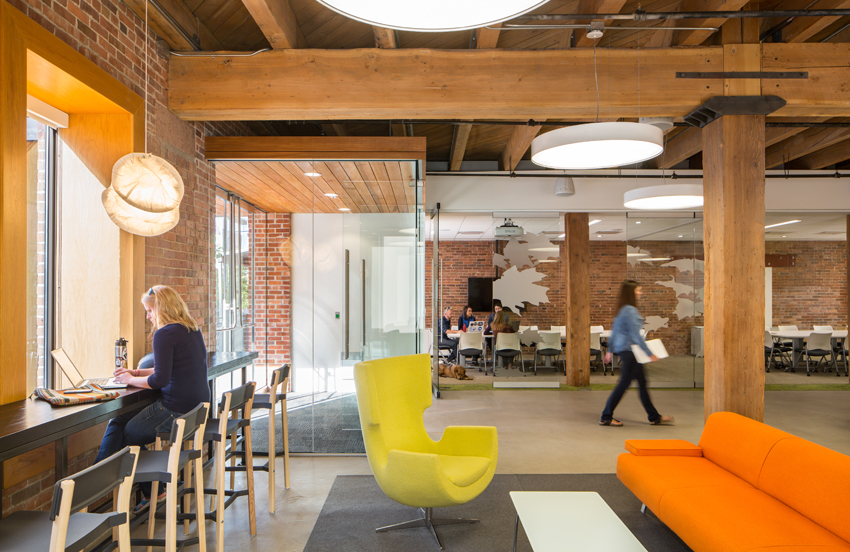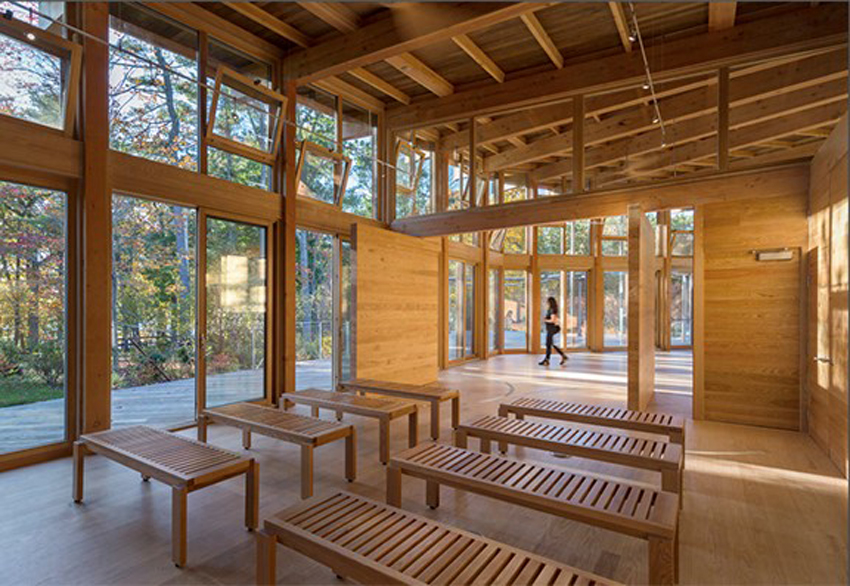How to Calculate the Wood Carbon Footprint of a Building
How Would an Increase In Demand For Wood Products Impact Forests?
Many builders and architects are concerned with the impact of increased demand for wood products on forests. Through both empirical evidence as well as economic models, we have found that demand for wood products results in more forest land, not less. One USFS study noted, “In general, the data show that global regions with the highest levels of industrial timber harvest and forest product output are also regions with the lowest rates of deforestation." The study goes on to add, "The alternative economic hypothesis suggests that forest products and industrial roundwood demands provide revenue and policy incentives to support sustainable forest management, and, in turn, industrial timber revenues and economical forest management have helped avoid large-scale systematic deforestation in those regions with the highest levels of industrial timber harvest.”26
Markets provide economic justification for sustainable forests and good forestry practices. The USFS states in the 2010 RPA assessment that, “Enhancing the flow of timber revenues helps to sustain forest management and provides an economic rationale for policies favoring sustainable forests and good forestry practices. If future technology development and wood demands provide enhanced timber revenues, then historic experience suggests that forests and forest management will thrive. If the value of timber declines, however, through low-value use, limited demand, or insufficient forest product technology development, the future sustainability of forests will be compromised.”27
The Intergovernmental Panel on Climate Change (IPCC) also concludes: “Sustainable forest management aimed at providing timber, fiber, biomass, non-timber resources, and other ecosystem functions and services can lower GHG emissions and can contribute to adaptation.”28
Increasing demand for timber can also increase carbon storage in product stocks and substitution benefits. According to the Forest Climate Working Group, which collaborates on forest carbon strategy and policy recommendations, the current inventory of wood structures in the United States is estimated to store 1.5 billion metric tons of carbon, which is equivalent to 5.4 billion tons of CO2. Most of this resides in the nation’s housing stock, about 80 percent of which is wood-frame construction. Increasing wood use to the maximum extent feasible in multifamily housing, low-rise non-residential construction, and remodeling could result in a carbon benefit equal to about 21 million metric tons of CO2 annually—the equivalent of removing 4.4 million cars.
Conclusion: Wood Supports a Sustainable Future
With growing pressure to reduce the environmental impacts of buildings, architects and engineers are looking beyond operational performance to the role of structural materials. In addition, clients are increasingly seeking buildings that meet or exceed green building codes or carbon policies. According to an analysis by the International Finance Corp., there is a business opportunity of almost $25 trillion associated with green buildings in emerging markets between now and 2030.29
Reasons to use wood to achieve a project’s sustainability goals are in many ways intuitive. Wood grows naturally, is renewable, and has advantages from a carbon footprint perspective. It is also durable, adaptable, and can have positive impacts on a building’s occupants. However, understanding a material’s impacts at every stage of its life is essential—and LCA studies consistently show that wood has a favorable environmental profile compared with functionally equivalent products made from other materials.
The use of wood also supports healthy demand for timber, which keeps land in forests and provides an incentive to grow more trees. Thus, increase in demand for wood can support investment in forests and ultimately increase supply. Forests can be managed to protect water quality, wildlife, soil, and areas of high conservation value. Assurances can be made through forest certification, responsible fiber sourcing certification, and state regulatory or voluntary best management practices. A wood building’s relatively low embodied footprint, carbon storage, and ties back to the forest provide a full suite of climate benefits.
The 2016 FAO report concluded, “Forests and forest products have a key role to play in mitigation and adaptation, not only because of their double role as sink and source of emissions, but also through the potential for wider use of wood products to displace more fossil-fuel intense products. Indeed, a virtuous cycle can be enacted in which forests increase removals of carbon from the atmosphere while sustainable forest management and forest products contribute to enhanced livelihoods and a lower carbon footprint.”30
It is worth reiterating that no one material is the best choice for every application. There are tradeoffs associated with each, and each has benefits that could outweigh the other material choices based on a project’s design objectives. It is important that specifiers be assured that using wood in North America can be part of a climate solution.
Edie Sonne Hall, Ph.D., has more than 20 years of experience in forestry, with expertise in carbon accounting, ecosystem services, life-cycle assessment, certification, and environmental and sustainability policy across local, federal, and international domains, working with the largest landowners in the world through to family farm forest organizations.
END NOTES
2architecture2030.org/new-buildings-embodied
3architecture2030.org/2030_challenges/embodied
4A Synthesis of Research on Wood Products and Greenhouse Gas Impacts, FPInnovations, 2010
6Pekka Leskinen, Giuseppe Cardellini, Sara González-García, Elias Hurmekoski, Roger Sathre, Jyri Seppälä, Carolyn Smyth, Tobias Stern and Pieter Johannes Verkerk. 2018. Substitution effects of wood-based products in climate change mitigation. From Science to Policy 7. European Forest Institute.
7Miner, R. & Gaudreault, C. 2016. Research Case 1: The potential of HWP in mitigation: additional storage of carbon in primary wood products. In Background papers on forests for a low-carbon future. Rome, FAO (in press).
8Estimates using Wood Works Carbon Estimator
9TRACI is a life cycle assessment methodology developed by the US EPA and the most commonly used method in North America.
10Athena Sustainable Materials Institute. 2019. User Manual and Transparency Document: Impact Estimator for Buildings v.5.
11Woodworks. 2015. Big Box Retail Comparison. WoodWorks Case Study WW-019.
12ISO. 2017. Sustainability in buildings and civil engineering works- Core rules for environmental product declarations of construction products and services. International Organization for Standardization. Second edition (ISO 21930:2017-07) 80pp.
13NC State University College of Agriculture & Life Sciences
14From USFS Office of Sustainability and Climate. 2019
15Salazar, J. “How LCA Handles Wood”, presentation to Carbon Leadership Forum’s Wood Carbon Seminar, May 7, 2020.
16Puettmann, M. 2020. The Role of Wood Products and Biomass Energy on Carbon Stores and Emissions. Chapter 4: In Carbon in Oregon’s Managed Forests. Cloughesy, M. and E.S. Hall (eds). Oregon Forest Resources Institute.
17364 million acres SFI; 158.2 million acres FSC; 17.6 million acres ATFS (US), American Tree Farm System, contacted June 2020; ~estimated 100 million CSA from SFI report as well as CSA SFM User Group
19National Forest Certification Study; An Evaluation of the Applicability of Forest Stewardship Council (FSC) and Sustainable Forest Initiative (SFI) Standards on Five National Forests, Pinchot Institute for Conservation
21State of America’s Forests. 2019
22www.epa.gov/ghgemissions/inventory-us-greenhouse-gas-emissions-and-sinks
23Oswalt, S.N., B.W. Smith, P.D. Miles, and S.A. Pugh. 2018. Forest Resources of the United States, 2017. A technical document supporting the Forest Service 2020 RPA assessment. Washington, DC: U.S. Forest Service.
24Ibid.
25Natural Resources Canada. 2019. The State of Canada’s Forests Annual Report 2019
26Ince, Peter. 2010. Sustainable development in the forest products industry, Chapter 2. Porto, Portugal : Universidade Fernando Pessoa, 2010: p. 29-41. ISBN: 9789896430528
27USFS, 2012: Future of America’s forest and rangelands: 2010 Resources Planning Act assessment. General Technical Report WO-87. 198 pp., U.S. Department of Agriculture, U.S. Forest Service, Washington, D.C.
28IPCC. 2019. IPCC Special Report on Climate Change, Desertification, Land Degradation, Sustainable Land Management, Food Security, and Greenhouse gas fluxes in Terrestrial Ecosystems.
29www.enr.com/articles/48389-a-call-to-action-for-engineers-on-climate-change
30FAO. 2016. Forestry for a Low Carbon Future.











